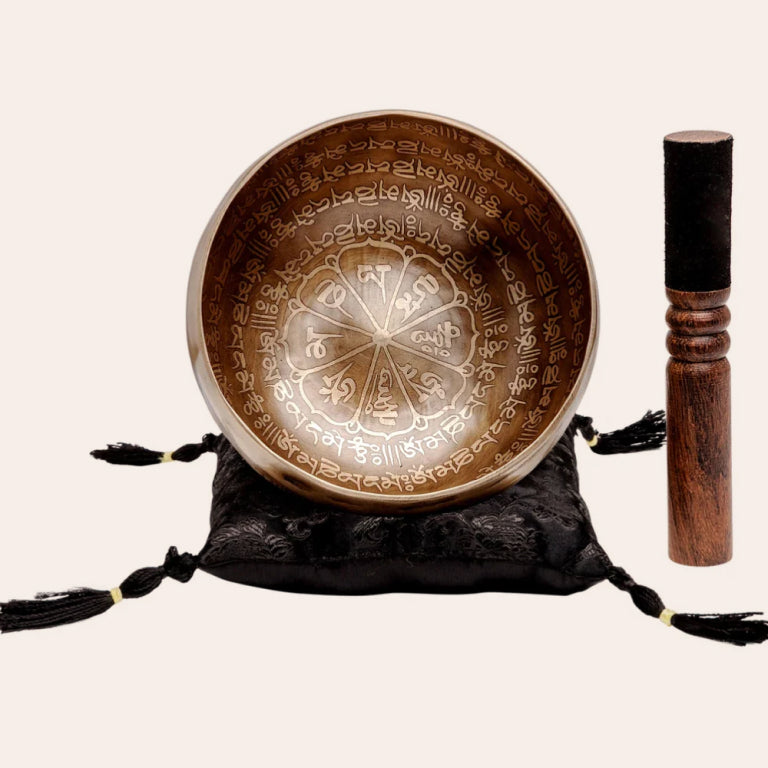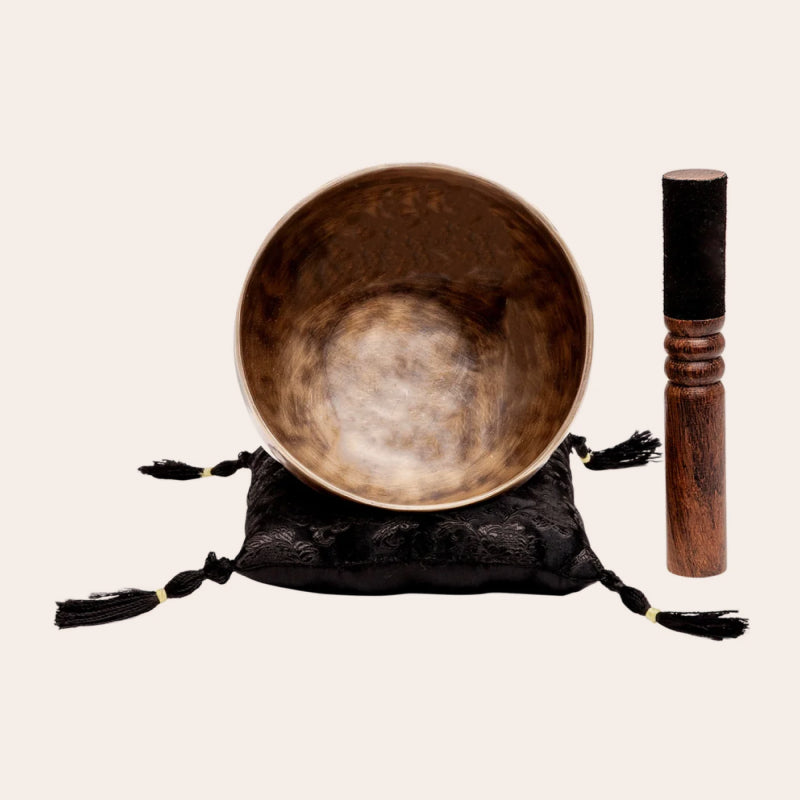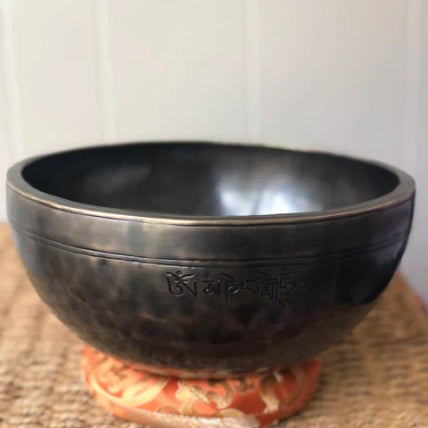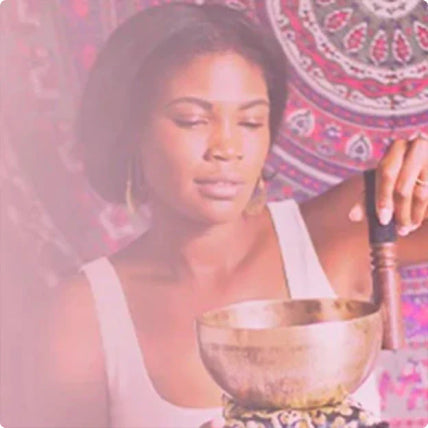6 Techniques To Play a Singing Bowl
Singing bowls are more than just an aesthetic addition to your home or space.
They create ethereal harmonies that heal the mind, body, cognition, behavior, and more.
So, how can you play your singing bowls to truly benefit from their power?
Because singing bowls have been in use for thousands of years, there isn’t any right or wrong way to play singing bowls.
People usually strike it or rim it, but you can add water to it or even use several Tibetan bowls at once.
Let's explore six major techniques to play your singing bowls.
How Did People Use Singing Bowls?
Singing bowls were first used to store grains, then as currency, gifts, and more.
The acoustic abilities of singing bowls, cup gongs, or Tibetan bowls found uses in prayer and spirituality too. Read more about singing bowl history.
From monks to healers, psychics, empaths, masseuses, Reiki masters, and musicians, many people use singing bowls these days. It can even be programmed with computers to different music for 1,000 years at once, as we saw in the article on the Longplayer Project.
When played, the sound of a singing bowl can tranquilize you, calm down anxiety, balance your breathing rate, regulate blood pressure, and stabilize hormones.
“The bell sound of a singing bowl cuts through the ‘noise’ of everyday life and connects us to a larger reality as it prepares our mind and spirit for meditation.” -Singing Bowls and Sacred Sound.
Here’s a video tutorial from the Ohm Store with Mindful Luna on the right way to play it:
How To Play Your Singing Bowl In 6 Different Ways?
Just like you can play the guitar in several ways, you can play the singing bowl in several ways too. It’s resonant from all sides when played with a mallet because the whole body of the bowl is acoustic.
Following are the different ways to play any singing bowl.
Striking or Gong Beat
The usual method of getting to know the sound of your bowl is by striking.
Striking the mallet softly, is an easy way to familiarize the singing bowl for all ages. It’s also good to start the bowl’s resonance at a high pitch. You can also try mallets of different sizes to find one that complements your bowl.
Here’s what you do:
- Pick the singing bowl and keep it in the palm of your left hand.
- Pick up the mallet with your right hand (your dominant hand).
- Holding the wooden part of the mallet, gently strike the wall of the singing bowl once.
- Instead of striking again, pause and feel the vibrations fading away.
- Striking softly is excellent for activating deep bass tones out of a cup gong.
- This is the male overtone of your bowl.
- That’s it!
Rimming
When you’ve gotten acquainted with striking, rimming introduces the actual way to make the bowl sing. It’s easy to rim a bowl to create beautiful sounds.
Moreover, you need to practice rimming your bowls to get better at playing the bowl.
This is how to do rim a sound bowl:
- Sit with your spine straight and breathe normally.
- Pick the bowl in your left hand.
- Hold the wooden part of the mallet in your right hand (or whichever is the dominant hand).
- Now, strike the singing bowl once.
- Bring back the mallet gently like a pen to move it along the curved edges of the bowl.
- Don’t let the sound die out.
- Continue while taking deep breaths.
- Circle the cup gong a few times in a clockwise direction.
- You’ll hear the female overtones.
- Continuing to stir will build the female overtone clearly with high trebles with both high and mid-tones.
Water Charging
You can also half-fill the bowl with water for a water charging session. Here’s an article that describes how to water charge Tibetan bowls correctly with dos and don’ts to keep in mind.
Water charging singing bowls are a great way to mute the sound of the singing bowl slightly. But always remember to pat dry the bowl after. This is because metals and alloys in the bowl may react to dampness.
Wah Wah Technique
One of the advanced techniques strictly for those who can hold and play singing bowls, the Wah Wah technique will be appealing. It mixes the sound of the bowl with your own.
You can do so in this way:
- Strike the bowl gently to wake it up while holding it in your palms at the level of your heart.
- Now perform the rimming technique.
- Stop playing by withdrawing the mallet and letting the bowl sing.
- Raise the bowl to your mouth so you can speak into it.
- Open and close your mouth while thinking of saying wah-wah.
In this method, your own sound is joined with the circular face of the bowl to reflect sound back and forth. This is a way of modulating the singing bowl sound with your positive affirmations.
Playing The Best Overtones Of A Sound Bowl
If you ask any person with a singing bowl, they’ll often talk about the Sweet Spot, where a bowl sounds the best. This is the best overtone of the bowl, and it’s different for every bowl.
Plus, you’ll have to spend time singing the bowl to find its sweet spot.
Moreover, your bowl may not even have it if it has super-thick walls. There are many differences in the sounds of a bowl because some can sing for a long time, while others don’t last over a minute. And then some last over two minutes!
So, play your singing bowls to find their sweet spots!
Playing Multiple Singing Bowls At Once
Lastly, you can play several singing bowls at once.
You can easily strike and rim different bowls at once by keeping a semicircle of singing bowls around you.
But before you start, remember that it’s better to keep large and medium bowls on the table above a cushion to create clear sound bath sessions. They’re resonant to bathe in sound waves!
All you have to take care of is the sound from dampening.
Small bowls can be handheld to strike or rim when other sounds fade away.
The sounds of multiple singing bowls also reflect each other. You can do this for meditation too.
14 Dos and Don’ts When Playing A Singing Bowl
Getting to know different ways to play a singing bowl is good. But you should also keep certain cautionary tips in mind to ensure you don’t damage the bowl.
Let’s look at it quickly!
Hold The Bowl Right
Hold your bowls properly in your palm without letting your fingers touch them. If your fingers touch the walls or the rim of the cup gong, it dampens the sound. As a result, the sound bowl will cease to sing!
Don’t Lose The Cushion
Always use the cushion you got with the Tibetan bowl to prevent the bottom from scratching. A crack or a scratch can damage the resonance and sound quality of the bowl in the long run.
You can avoid the bowl from falling off and breaking by keeping it on a table with the cushion it came in. Read more about 11 different types of singing bowl cushions on our blog next.
Use The Right Mallet
Always pick the right mallet for your bowl.
For instance, small mallets are good for small bowls. Remember that wood is suitable for bowls with high overtones and leather for the vibrational effect.
Use the Mallet The Right Way
Always hold your mallet vertically like you’re stirring a pot of soup. This ensures you have a full arm movement instead of just a wrist movement.
Seasoning The Mallet
When you first get the mallet, the leather isn’t broken into. It may be stiff or rough. By playing the singing bowl many times with your new mallet, it will become soft and gentle after playing the bowl for a long time too.
Not too hard
When it comes to metal singing bowls, most people think they’re invincible as they’re made of metal. However, even metal singing bowls are incredibly fragile, just like a diamond can break when hit at its exact cleavage.
So, don’t strike your bowls too hard. Always go low-to-high to see how well your bowl takes it!
Not Too Loud
You shouldn’t play the bowl too loud because it can become too much for the bowl to handle. Some bowls can even crack when it’s suddenly slowing down after high-pressure rimming.
Not too Tight or Light
To play the singing bowl properly, don’t hold the mallet too tight, or it will add to the pressure. Too light, and it will dampen out the sounds!
Go At Your Pace
It’s essential to find your speed of playing the bowl at ease. It could be fast or slow based on how you want to go. That’s why it’s good to choose a quiet and peaceful space to practice playing your bowl first.
Don’t Keep The Bowls Too Close
When you’re playing multiple singing bowls at once, it’s important not to keep too many bowls together. If you do, they can rattle and shatter with high resonance.
Mix up the techniques
Always try to play your bowl the way you want to. This way, you’ll discover new tones and sound vibrations with your bowl. The rule of thumb is- to follow your intuition.
Don’t Let It Rattle
The rattling sound happens when the vibrations of your bowl are so strong, that it's knocking the striker off the surface. When this happens, consider slowly down and applying less pressure to the mallet. Hence, add more pressure to your grip when playing the bowl.
Different bowls are Different
One important thing people forget is that some Tibetan bowls are tailored for striking and might not sing in such a case. Hence, you shouldn’t try to rim those bowls. They’re better when playing several bowls at once.
Don’t forget to inhale and exhale
Before you go, remember to practice deep breaths when you’re working with singing bowls. This helps to soak into the healing sound vibrations well.
Which Is Your Favorite Way Of Playing The Singing Bowl?
Singing bowls can be played any way you want as long as you’re not too loud, hard, tight, and loose. All you need to keep in mind is the full-arm movement.
Once you’ve readied your bowl, feel free to strike, rim, or water-charge it. You can play it to find the sweet spot or do the Wah-Wah technique.
If you have more than one singing bowl, try to play several of them at once to create a healing harmony in your next meditation session with singing bowls.
How do you like to play your singing bowl? Share it with our family at Ohm Store!










